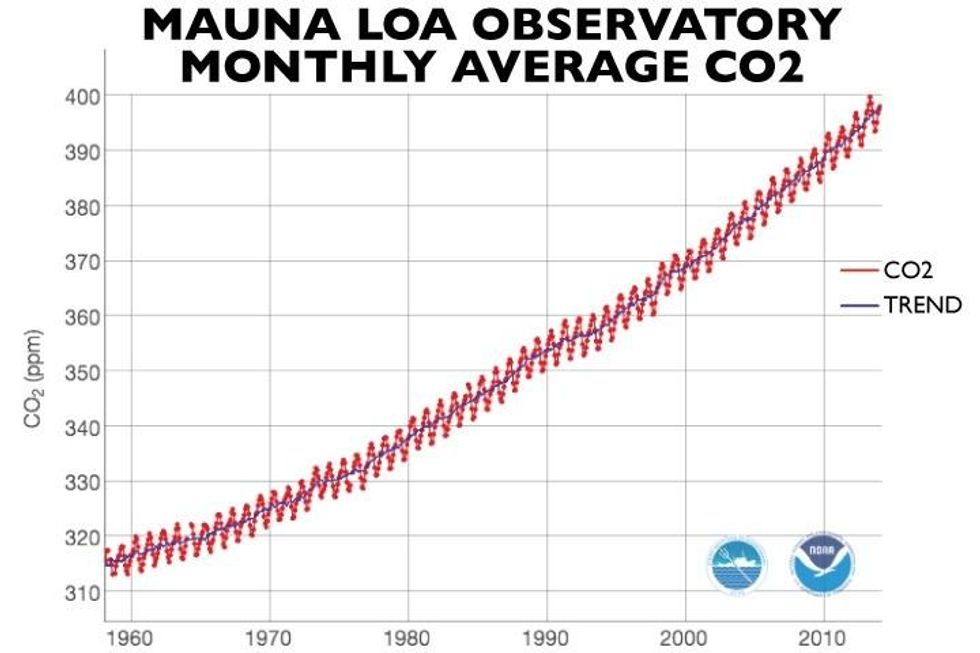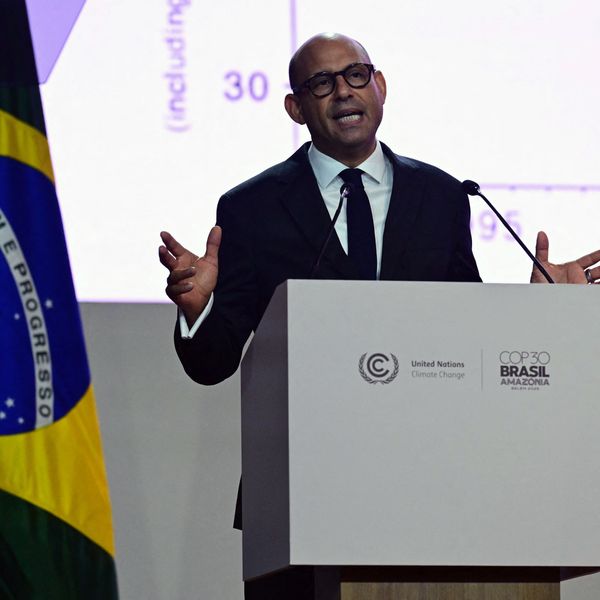400 PPM: 'Just a Matter of Time' Before We Cross Climate Threshold 'Forever'
Fossil fuel burning increasing greenhouse gases to levels 'not seen in human history'

And according to Ralph Keeling, who runs the carbon dioxide monitoring program at the Scripps Institute of Oceanography, that atmospheric concentration was recorded last week for the first time this year, two months earlier than last. Now, warns Keeling, it is only a matter of time before the atmosphere permanently maintains those levels.
"We're already seeing values over 400. Probably we'll see values dwelling over 400 in April and May. It's just a matter of time before it stays over 400 forever," said Keeling whose team at Scripps have taken daily measurements from the Mauna Loa Observatory in Hawaii since March 1958 when carbon was at 313 ppm.
The 400 parts per million threshold was first recorded during a brief moment in the month of May last year, notes Brian Kahn at Climate Central. It was the first time carbon levels had reached that high in human history.
But as Robert Monroe writes on Keeling's blog, "Fossil fuel burning continues to increase concentrations of the greenhouse gas to levels not seen in human history and not in perhaps as many as 3 to 5 million years."
According to Monroe:
Instruments at the Mauna Loa Observatory in Hawaii recorded atmospheric levels of carbon dioxide greater than 400 parts per million on March 12, 2014 nearly two months earlier than the date on which the milestone was passed in 2013.
Scripps Institution of Oceanography, UC San Diego, reported a reading of 401.62 ppm on March 12 and a reading of 400.2 on March 13. Readings by instruments operated by NOAA also exceeded 400 ppm on those days.
In a related story on Tuesday, the American Association for the Advancement of Science (AAAS) released a series of key messages and videos calling on Americans to wake up to the threat of climate change, which is likely to cause "abrupt, unpredictable and potentially irreversible" changes to the world's ecosystems and subsequently the lives of billions of people. Americans must act quickly to reduce greenhouse gas emissions and avoid the worst case climate-change scenario, the scientists warn.
______________________
An Urgent Message From Our Co-Founder
Dear Common Dreams reader, The U.S. is on a fast track to authoritarianism like nothing I've ever seen. Meanwhile, corporate news outlets are utterly capitulating to Trump, twisting their coverage to avoid drawing his ire while lining up to stuff cash in his pockets. That's why I believe that Common Dreams is doing the best and most consequential reporting that we've ever done. Our small but mighty team is a progressive reporting powerhouse, covering the news every day that the corporate media never will. Our mission has always been simple: To inform. To inspire. And to ignite change for the common good. Now here's the key piece that I want all our readers to understand: None of this would be possible without your financial support. That's not just some fundraising cliche. It's the absolute and literal truth. We don't accept corporate advertising and never will. We don't have a paywall because we don't think people should be blocked from critical news based on their ability to pay. Everything we do is funded by the donations of readers like you. Will you donate now to help power the nonprofit, independent reporting of Common Dreams? Thank you for being a vital member of our community. Together, we can keep independent journalism alive when it’s needed most. - Craig Brown, Co-founder |

And according to Ralph Keeling, who runs the carbon dioxide monitoring program at the Scripps Institute of Oceanography, that atmospheric concentration was recorded last week for the first time this year, two months earlier than last. Now, warns Keeling, it is only a matter of time before the atmosphere permanently maintains those levels.
"We're already seeing values over 400. Probably we'll see values dwelling over 400 in April and May. It's just a matter of time before it stays over 400 forever," said Keeling whose team at Scripps have taken daily measurements from the Mauna Loa Observatory in Hawaii since March 1958 when carbon was at 313 ppm.
The 400 parts per million threshold was first recorded during a brief moment in the month of May last year, notes Brian Kahn at Climate Central. It was the first time carbon levels had reached that high in human history.
But as Robert Monroe writes on Keeling's blog, "Fossil fuel burning continues to increase concentrations of the greenhouse gas to levels not seen in human history and not in perhaps as many as 3 to 5 million years."
According to Monroe:
Instruments at the Mauna Loa Observatory in Hawaii recorded atmospheric levels of carbon dioxide greater than 400 parts per million on March 12, 2014 nearly two months earlier than the date on which the milestone was passed in 2013.
Scripps Institution of Oceanography, UC San Diego, reported a reading of 401.62 ppm on March 12 and a reading of 400.2 on March 13. Readings by instruments operated by NOAA also exceeded 400 ppm on those days.
In a related story on Tuesday, the American Association for the Advancement of Science (AAAS) released a series of key messages and videos calling on Americans to wake up to the threat of climate change, which is likely to cause "abrupt, unpredictable and potentially irreversible" changes to the world's ecosystems and subsequently the lives of billions of people. Americans must act quickly to reduce greenhouse gas emissions and avoid the worst case climate-change scenario, the scientists warn.
______________________

And according to Ralph Keeling, who runs the carbon dioxide monitoring program at the Scripps Institute of Oceanography, that atmospheric concentration was recorded last week for the first time this year, two months earlier than last. Now, warns Keeling, it is only a matter of time before the atmosphere permanently maintains those levels.
"We're already seeing values over 400. Probably we'll see values dwelling over 400 in April and May. It's just a matter of time before it stays over 400 forever," said Keeling whose team at Scripps have taken daily measurements from the Mauna Loa Observatory in Hawaii since March 1958 when carbon was at 313 ppm.
The 400 parts per million threshold was first recorded during a brief moment in the month of May last year, notes Brian Kahn at Climate Central. It was the first time carbon levels had reached that high in human history.
But as Robert Monroe writes on Keeling's blog, "Fossil fuel burning continues to increase concentrations of the greenhouse gas to levels not seen in human history and not in perhaps as many as 3 to 5 million years."
According to Monroe:
Instruments at the Mauna Loa Observatory in Hawaii recorded atmospheric levels of carbon dioxide greater than 400 parts per million on March 12, 2014 nearly two months earlier than the date on which the milestone was passed in 2013.
Scripps Institution of Oceanography, UC San Diego, reported a reading of 401.62 ppm on March 12 and a reading of 400.2 on March 13. Readings by instruments operated by NOAA also exceeded 400 ppm on those days.
In a related story on Tuesday, the American Association for the Advancement of Science (AAAS) released a series of key messages and videos calling on Americans to wake up to the threat of climate change, which is likely to cause "abrupt, unpredictable and potentially irreversible" changes to the world's ecosystems and subsequently the lives of billions of people. Americans must act quickly to reduce greenhouse gas emissions and avoid the worst case climate-change scenario, the scientists warn.
______________________

